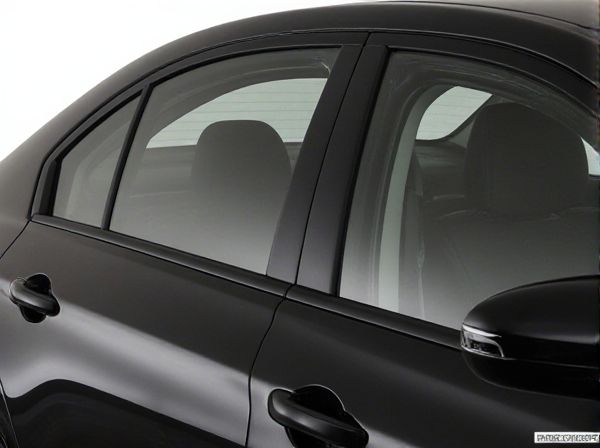
Photo illustration: One-Touch Window vs Standard Power Window
One-touch windows offer the convenience of fully opening or closing your car windows with a single press, enhancing ease of use during driving. Standard power windows require you to hold the switch until the window reaches the desired position, which can be less efficient and distracting. Choosing one-touch windows improves safety and comfort, especially when you need quick adjustments on the road.
Table of Comparison
| Feature | One-Touch Window | Standard Power Window |
|---|---|---|
| Operation | Single press for full open/close | Hold button to open/close |
| Convenience | High - faster window control | Moderate - requires continuous press |
| Safety | Auto-reverse anti-pinch feature | Standard safety without auto-reverse |
| Cost | Higher - advanced mechanism | Lower - basic mechanism |
| Installation | Complex - integrated with vehicle electronics | Simple - basic wiring |
| Power Consumption | Efficient - one-touch motor control | Continuous power during operation |
Introduction to Automotive Window Technologies
One-Touch Window technology enables a fully automated window operation with a single press, enhancing driver convenience and safety by reducing distraction. Standard Power Windows require continuous pressure on the switch to operate, which can be less efficient and more cumbersome. Advanced sensors and motor controls differentiate One-Touch Windows, making them a preferred choice in modern automotive designs for seamless user experience and improved functionality.
What is a One-Touch Window?
A One-Touch Window is a power window feature that allows the driver or passenger to fully open or close the window with a single press of the switch, enhancing convenience and safety. Unlike standard power windows, which require holding the button throughout the operation, One-Touch Windows use an automated motorized mechanism triggered by the initial press. This technology reduces driver distraction and improves ease of use in modern vehicles.
Understanding Standard Power Windows
Standard power windows operate with a simple switch mechanism that requires the user to hold the button until the window reaches the desired position, offering manual control without automated features. These windows rely on an electric motor and regulator to raise or lower the glass, providing reliable functionality and easy integration into most vehicle models. Compared to one-touch windows, standard power windows lack automatic up or down preset capabilities, requiring continuous user input for operation.
Key Differences: One-Touch vs Standard Power Windows
One-touch windows enable the entire window to open or close with a single press, enhancing convenience and reducing driver distraction, while standard power windows require continuous pressing to operate. One-touch systems often feature auto-reversal for safety, detecting obstructions to prevent injury, a function typically absent in standard power windows. The advanced motor and control mechanisms in one-touch windows contribute to smoother, faster operation compared to the manual holding needed in standard power window systems.
User Convenience and Ease of Operation
One-Touch Windows allow users to fully open or close windows with a single press, significantly enhancing convenience during driving by minimizing distractions. Standard Power Windows require continuous pressing, which can be less ergonomic and more time-consuming, especially in situations requiring frequent adjustments. The automatic feature of One-Touch Windows improves ease of operation, making it ideal for drivers seeking efficiency and safety.
Safety Features and Considerations
One-touch windows enhance safety by allowing drivers to open or close windows fully with a single tap, reducing distraction and minimizing the time hands are off the wheel. They often include anti-pinch sensors that detect obstructions, preventing injury by stopping or reversing window movement. Standard power windows lack these automatic stop features, increasing potential risks, especially for children and pets inside the vehicle.
Installation and Maintenance Insights
One-touch windows offer a simplified installation process due to integrated control modules that reduce wiring complexity compared to standard power windows. Maintenance for one-touch systems involves occasional software updates and sensor calibrations to ensure functionality, while standard power windows primarily require mechanical inspections and wiring checks. Choosing one-touch windows can enhance convenience but may increase electronic component servicing needs over time.
Cost Comparison and Value Proposition
One-touch windows generally cost 20-30% more than standard power windows due to advanced sensors and control modules that enhance convenience and safety. The higher initial investment offers substantial value by reducing driver distraction and improving ease of use, particularly in multi-window applications. Standard power windows, while more affordable, lack automation features that contribute to long-term comfort and efficiency.
Common Problems and Troubleshooting
One-touch windows often encounter issues such as sensor malfunctions, misaligned window tracks, and faulty limit switches, which can cause the window to stop mid-operation or reverse unexpectedly. Standard power windows commonly face problems with worn-out window regulators, broken motor gears, or faulty wiring that result in slow or unresponsive window movement. Troubleshooting these issues typically involves inspecting the window switch, checking the motor and regulator assembly, and resetting the one-touch window system using a specific relearning procedure.
Choosing the Right Window System for Your Car
One-touch windows offer enhanced convenience by allowing the window to fully open or close with a single press, reducing driver distraction compared to standard power windows that require continuous button hold. Prioritizing a one-touch system improves safety and user experience, especially during frequent or emergency adjustments. Consider compatibility with your vehicle's electrical system and potential cost differences when choosing the right window system for optimal functionality and ease of use.
 caratoz.com
caratoz.com